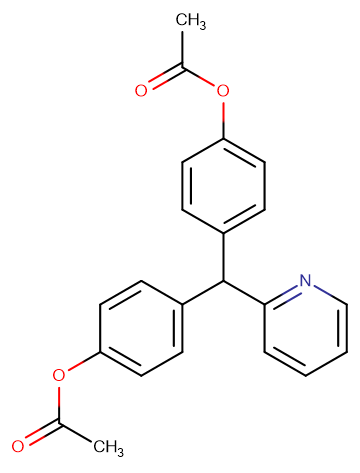
Bisacodyl
CAS No. 603-50-9
Bisacodyl( Bisacodyl, Durolax, Dulcolax, Fenilaxan, Neolax, Ulcolax )
Catalog No. M15257 CAS No. 603-50-9
Bisacodyl (INN) is a stimulant laxative drug that works directly on the colon to produce a bowel movement.
Purity : >98% (HPLC)
 COA
COA
 Datasheet
Datasheet
 HNMR
HNMR
 HPLC
HPLC
 MSDS
MSDS
 Handing Instructions
Handing Instructions
| Size | Price / USD | Stock | Quantity |
| 500MG | 38 | In Stock |


|
| 1G | Get Quote | In Stock |


|
Biological Information
-
Product NameBisacodyl
-
NoteResearch use only, not for human use.
-
Brief DescriptionBisacodyl (INN) is a stimulant laxative drug that works directly on the colon to produce a bowel movement.
-
DescriptionBisacodyl (INN) is a stimulant laxative drug that works directly on the colon to produce a bowel movement.(In Vivo):Bisacodyl (20 mg/kg) results in a decrease in AQP3 protein expression and increased mRNA expression level of TNF-α in the colon of rats . Bisacodyl inhibits water absorption in rat jejunum, ileum, and colon, the degree of inhibition is linearly related to the logarithm of the bisacodyl concentration over the range of 0.05 mg to 2.0 mg per 100 mL . Bisacodyl (10 mg/kg, intragastrically) induces a significant decrease in jejunal NOS activity in rats. Bisacodyl (10 mg/kg, intragastrically) increases the distance traveled by the marker in all time periods . Bisacodyl (5.9 mg/kg) decreases significantly jejunal and colonic (Na + K) ATPase activity as compared to saline-treated rats. Bisacodyl (5.9 mg/kg) increases significantly jejunal and colonic PGE2 content and stimulates jejunal and colonic adenyl cyclase activity as compared to those in control rats without affecting cAMP content . Bisacodyl (4.3 mg/kg) coupled with AOM increases the number of crypt per focus, but not the number of tumors in rats. Bisacodyl (43 mg/kg) significantly increases the number of crypt per focus and tumors in rats .
-
In Vitro——
-
In VivoBisacodyl (20 mg/kg) results in a decrease in AQP3 protein expression and increased mRNA expression level of TNF-α in the colon of rats . Bisacodyl inhibits water absorption in rat jejunum, ileum, and colon, the degree of inhibition is linearly related to the logarithm of the bisacodyl concentration over the range of 0.05 mg to 2.0 mg per 100 mL . Bisacodyl (10 mg/kg, intragastrically) induces a significant decrease in jejunal NOS activity in rats. Bisacodyl (10 mg/kg, intragastrically) increases the distance traveled by the marker in all time periods . Bisacodyl (5.9 mg/kg) decreases significantly jejunal and colonic (Na + K) ATPase activity as compared to saline-treated rats. Bisacodyl (5.9 mg/kg) increases significantly jejunal and colonic PGE2 content and stimulates jejunal and colonic adenyl cyclase activity as compared to those in control rats without affecting cAMP content . Bisacodyl (4.3 mg/kg) coupled with AOM increases the number of crypt per focus, but not the number of tumors in rats. Bisacodyl (43 mg/kg) significantly increases the number of crypt per focus and tumors in rats .
-
SynonymsBisacodyl, Durolax, Dulcolax, Fenilaxan, Neolax, Ulcolax
-
PathwayOthers
-
TargetOther Targets
-
RecptorOthers
-
Research AreaMetabolic Disease
-
Indication——
Chemical Information
-
CAS Number603-50-9
-
Formula Weight361.39
-
Molecular FormulaC22H19NO4
-
Purity>98% (HPLC)
-
SolubilityDMSO: 72 mg/mL (199.23 mM)
-
SMILESCC(OC1=CC=C(C(C2=CC=C(OC(C)=O)C=C2)C3=NC=CC=C3)C=C1)=O
-
Chemical Name(pyridin-2-ylmethylene)bis(4,1-phenylene) diacetate
Shipping & Storage Information
-
Storage(-20℃)
-
ShippingWith Ice Pack
-
Stability≥ 2 years
Reference
1.Ikarashi N, et al. Am J Physiol Gastrointest Liver Physiol, 2011, 301(5), G887-895.
molnova catalog



related products
-
1-(cyclohexylmethyl)...
1-(cyclohexylmethyl)guanidine hydroiodide is a chemical compound.
-
Ly93
Ly93 is a selective and orally active sphingomyelin synthase 2 (SMS2) inhibitor (IC50: 91 nM) used for studying atherosclerosis.
-
Salusin- β
Salusin- β



 Cart
Cart
 sales@molnova.com
sales@molnova.com


